Covalent bonds - Study guides, Class notes & Summaries
Looking for the best study guides, study notes and summaries about Covalent bonds? On this page you'll find 6122 study documents about Covalent bonds.
Page 4 out of 6.122 results
Sort by
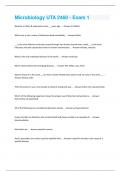
-
Microbiology UTA 2460 - Exam 1 questions and answers graded A+
- Exam (elaborations) • 5 pages • 2024
- Available in package deal
-
- CA$11.33
- 1x sold
- + learn more
Bacteria, archaea & eukaryotes arose __ years ago... - Answer-2.9 Billion Which one is not a cause of infectious death worldwide... - Answer-Ebola __ is the most infectious microbe caused through non-human transmission, while __ is the most infectious microbe caused by human-to-human transmission... - Answer-malaria, measles What is the only eradicated disease in the world... - Answer-small pox Which choice below lists emerging diseases... - Answer-HIV, SARS, Lassa Fever Species that are i...
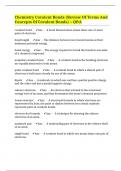
-
Chemistry Covalent Bonds (Review Of Terms And Concepts Of Covalent Bonds) – Q&A
- Exam (elaborations) • 3 pages • 2023
- Available in package deal
-
- CA$12.04
- + learn more
Chemistry Covalent Bonds (Review Of Terms And Concepts Of Covalent Bonds) – Q&A
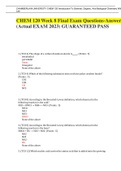
-
CHEM 120 Week 8 Final Exam Questions-Answers (Actual EXAM 2023) GUARANTEED PASS
- Exam (elaborations) • 6 pages • 2023
-
- CA$15.60
- 4x sold
- + learn more
CHEM 120 Week 8 Final Exam Questions-Answers (Actual EXAM 2023) GUARANTEED PASS he shape of a carbon dioxide molecule is _____. Question (TCO 4) Which of the following substances does not have polar covalent bonds? Question (TCO 8) According to the Bronsted-Lowry definition, which chemical in the following reaction is the acid? Question (TCO 8) According to the Bronsted-Lowry definition, which chemical in the following reaction is the base? Question (TCO 12) Which nucleic acid carries...
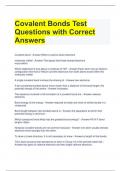
-
BUNDLE FOR Covalent bonds Exam Questions with Correct Answers
- Package deal • 7 items • 2023
-
- CA$40.96
- + learn more
1 Exam (elaborations) Covalent Bonds Exam Questions and Answers All Correct 2 Exam (elaborations) Covalent bonds Exam Questions with Correct Answers 3 Exam (elaborations) Covalent Bonds Test Questions with Correct Answers 4 Exam (elaborations) Covalent Bonds Test Questions and Answers 5 Exam (elaborations) Covalent Bonding Exam Questions with C
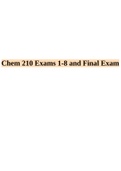
-
CHEM 210 Biochemistry Exams 1-8 and Final Exam.
- Exam (elaborations) • 125 pages • 2023
- Available in package deal
-
- CA$15.58
- 3x sold
- + learn more
CHEM 210 Biochemistry Exams 1-8 and Final Exam. Question 1 3 / 3 pts True or False: According to the Module, a compound with a molecular mass of 1,000 g/mol is considered a macromolecule. True Correct! False Question 2 3 / 3 pts True or False: Biomolecules can have only two functional groups. True Correct! False Question 3 3 / 3 pts True or False: The following functional group is an alcohol. True Correct! False Question 4 3 / 3 pts True or False: In a eukaryot...
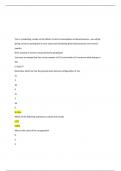
-
CHEM 120 Week 3 Exam 1 (Units 1 & 2)
- Exam (elaborations) • 3 pages • 2023
- Available in package deal
-
- CA$31.18
- 1x sold
- + learn more
1. You re conducting a study on the effects of carrot consumption on blood pressure. you will be giving carrots to participants in your study and monitoring their blood pressure over several months 2. Which of the following substances contain ionic bonds? 3. What is the name of the compound N 4. Which of the following species would you expect form intermolecular hydrogen bonds? 5. In an experiment you calculate that 6.50 gram of liquid has a volume of 2.50 ml…. What is the mass of a 160 l...
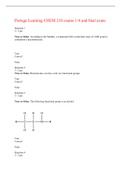
-
PORTAGE LEARNING CHEM 210 exams 1-8 and final exam
- Exam (elaborations) • 124 pages • 2023
-
- CA$41.11
- 5x sold
- + learn more
Portage Learning CHEM 210 exams 1-8 and final exam Question 1 3 / 3 pts True or False: According to the Module, a compound with a molecular mass of 1,000 g/mol is considered a macromolecule. True Correct! False Question 2 3 / 3 pts True or False: Biomolecules can have only two functional groups. True Correct! False Question 3 3 / 3 pts True or False: The following functional group is an alcohol. True Correct! False Question 4 3 / 3 pts True or False: In ...
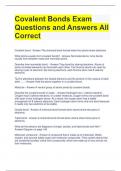
-
Covalent Bonds Exam Questions and Answers All Correct
- Exam (elaborations) • 3 pages • 2023
- Available in package deal
-
- CA$18.42
- + learn more
Covalent Bonds Exam Questions and Answers All Correct Covalent bond - Answer-The chemical bond formed when two atoms share electrons What atoms usually form covalent bonds? - Answer-Nonmetal atoms. Ionic bonds usually form between metal and nonmetal atoms. Describe how nonmetals bond. - Answer-They bond by sharing electrons. Atoms of some nonmetal elements can bond with each other. Two fluorine atoms can react by sharing a pair of electrons. By sharing electrons, each fluorine atom has...
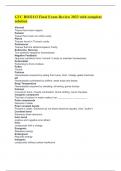
-
GTC BIO2113 Final Exam Review 2023 with complete solution
- Exam (elaborations) • 11 pages • 2023
-
- CA$17.00
- 2x sold
- + learn more
GTC BIO2113 Final Exam Review 2023 with complete solution Visceral Tissue that covers organs Parietal Tissue that covers an entire cavity Pleura Tissues found in Thoracic cavity Peritoneum Tissues that line Abdominopelvic Cavity Endocrine, Nervous Two systems integral to homeostasis Negative Feedback Opposes variations from "normal" in body to maintain homeostasis Antecubital Pertaining to front of elbow Pollex Thumb Calcium Homeostasis acquired by taking from bone, food. V...
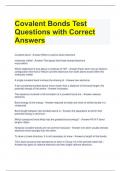
-
Covalent Bonds Test Questions with Correct Answers
- Exam (elaborations) • 3 pages • 2023
- Available in package deal
-
- CA$18.42
- + learn more
Covalent Bonds Test Questions with Correct Answers Covalent bond - Answer-When to atoms share electrons molecular orbital - Answer-The space that these shared electrons move within Which statement is true about a molecule of H2? - Answer-Each atom has an electron configuration like that of Helium and the electrons from both atoms travel within the molecular orbital. A single covalent bond involves the sharing of - Answer-two electrons. If two covalently bonded atoms move closer ...

Study stress? For sellers on Stuvia, these are actually golden times. KA-CHING! Earn from your study resources too and start uploading now. Discover all about earning on Stuvia


